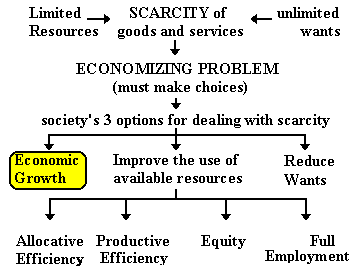
From the 5Es lesson:
 |
Economic Growth is one of the "5 Es of economics or one of the five ways for a society to reduce scarcity.
Let's define Economic Growth as an increase in the ABILITY to produce goods and services. This is not the way the term is normally defined. Later this semester we'll discuss the various definitions of Economic Growth, but here we'll use this more fundamental definition:
Economic Growth is an increase in the ABILITY to produce goods and services.
This means we are ABLE to produce more, but it doesn't necessarily mean we do produce more. More on this later.
This type of Economic Growth is caused by:
a) more resources
b) better resources
c) better technology
If we only had more resources we could produce more goods and services and satisfy more of our wants. This will reduce scarcity and give us more satisfaction (more good and services). All societies therefore try to achieve economic growth.
From Production Possibilities lesson - Economic Growth
In Macroeconomics we study three main issues:
We can use the production possibilities model to demonstrate how economic growth can reduce scarcity.
Our multimedia lesson use several definitions of economic growth. let me review them here.
Three Definitions of Economic Growth
(1) Increasing our POTENTIAL OUTPUT
I like to call this increasing our ABILITY to Produce. this is the definition we used in the 5Es lesson. This is the most fundamental definition of economic growth. It is the type of economic growth used on out 5Es diagram.
We can increase our ABILITY to produce goods and services (or increase our POTENTIAL GDP) if we get:
- more resources
- better resources, and
- better technology
Since this increase maximum output that we are able to produce it shifts the PPF outward. On the graph below, economic growth would cause the PPF to move from PP1 to PP2.
This doesn't necessarily mean that the economy IS producing more, just that it CAN produce more. To achieve our new potential levels of output we also need full employment and productive efficiency. It could be possible to have this type of economic growth so that we CAN produce the quantities represented by point E, but if there is unemployment and productive inefficiency we would be at a point beneath this new curve (maybe point C). So we may get new resources or new technology so we CAN produce more (point E on PP2), but if we don't use the new resources (i.e. we have unemployment) or if we don't use the new technology (i.e. we have productive inefficiency) , we may remain on PP1 (point C).
(2) Increasing Output (or ACHIEVING our potential output)
The most commonly used definition of economic growth is simply producing more. (Later we will call this INCREASING REAL GDP.)When an economy increases its output it is often said to have achieved economic growth. But if by producing more we are simply ACHIEVING OUR POTENTIAL, then we could also say that it is REDUCING UNEMPLOYMENT or ACHIEVING PRODUCTIVE EFFICIENCY. On our graph this would be represented by moving from point D to a point on the curve: A, B, or C).
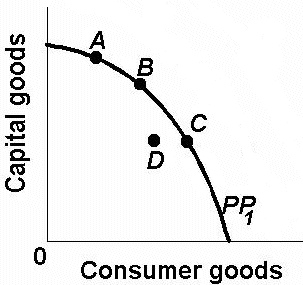
(3) Increasing Real GDP per capita
The definition of economic growth used in our multimedia lesson on economic growth () is an increase in GDP per capita. This means increasing output per person. GDP per capita is calculated by dividing output by the population.
From the AS - AD Lesson:
Economic Growth
What about economic growth? In an earlier lesson we discussed three definitions of economic growth
- Increasing our POTENTIAL OUTPUT
- Increasing Output, and
- Increasing Real GDP per capita
(1) Increasing our POTENTIAL OUTPUT
I like to call this increasing our ABILITY to produce. This is the definition we used in the 5 Es lesson. This is the most fundamental definition of economic growth. It is the type of economic growth used on our 5 Es diagram.
We can increase our ABILITY to produce goods and services (or increase our POTENTIAL GDP) if we get:
- more resources
- better resources, and
- better technology
Since this increases maximum output that we are able to produce it shifts the PPF outward. On the graph below, economic growth would cause the PPF to move from PP1 to PP2.
This doesn't necessarily mean that the economy IS producing more, just that it CAN produce more. To achieve our new potential levels of output we also need full employment and productive efficiency. It could be possible to have this type of economic growth so that we CAN produce the quantities represented by point E, but if there is unemployment and productive inefficiency we would be at a point beneath this new curve (maybe point C). So we may get new resources or new technology so we CAN produce more (point E on PP2), but if we don't use the new resources (i.e. we have unemployment) or if we don't use the new technology (i.e. we have productive inefficiency) , we may remain on PP1 (point C).
In the AS-AD model INCREASING OUR POTENTIAL OUTPUT is represented by in increase in AS.
Notice that when AS increases, the full employment level of output increase from RDO-FE1 to RDO-FE2. this is an increase in our potential level of output.
In the 5 Es lecture we said that economic growth is caused by:
- more resources
- better resources, or
- better technology
An increase in the production possibilities curve is caused by having more resources, better resources, or better technology.
An increase in AS is caused by:
- a decrease in the price of resources
- an increase in productivity
- lower business taxes and government red tape
These are all really the same thing.
(2) Increasing Output (or ACHIEVING out potential)
The most commonly used definition of economic growth is simply producing more. (Later we will call this INCREASING REAL GDP.)When an economy increases its output it is often said to have achieved economic growth. But if by producing more we are simply ACHIEVING OUR POTENTIAL, then we could also say that it is REDUCING UNEMPLOYMENT or ACHIEVING PRODUCTIVE EFFICIENCY. On our graph this would be represented by moving from point D to a point on the curve: A, B, or C).
On our AD-AS model we could illustrate this type of growth (producing more) by an increase in AD.
Notice that output increase from RDO-EQUIL to RDO', but the full employment level of output, which is our potential level of output, does not change (RDO-FE).
If Ad increase so that equilibrium is at the full employment level of output, it is analogous to going from a point inside the production possibilities curve to a point on the curve.
(3) Increasing Real GDP per capita
The definition of economic growth used in our multimedia lesson on economic growth () is an increase in GDP per capita. This means increasing output per person. GDP per capita is calculated by dividing output by the population.
Economic Growth: Three Definitions - REVIEW
1. Increasing our ABILITY to Produce (INCREASING potential output)
a. "economic growth" on the 5Es chart
b. shifting out to a new production possibilities curve
c. AS
d. causes:(1) change in input prices (more resources)
(2) changes in the productivity of resource (better res., better tech.)
(3). legal-institutional environment
2. Increasing output or increasing Real GDP (ACHIEVING our potential)
a. achieving "full employment" and "productive efficiency" (5Es)
b. going from a point inside the PPC to a point closer to the PPC
c. AD
d. increasing GDP per capita
e. causes:(1) producing at a minimum cost to achieve productive efficiency(a) not using more resources than necessary
(b) using resources where they are best suited
(c) Using the appropriate technology(2) more spending to AD and achieve full employment
(a) C
(b) I
(c) G
(d) Xn
3. GDP per capita: real GDP at a faster rate than the population
IV. Growth in the United States
A. The Facts
B. But:
I. Economic Growth-how to increase the economy's productive capacity over time.
A. Two definitions of economics growth are given.1. The increase in real GDP, which occurs over a period of time.2. The increase in real GDP per capita, which occurs over time. This definition is superior if comparison of living standards is desired. For example, China's 2003 GDP was $1410 billion compared to Denmark's $212 billion, but per capita GDP's were $1110 and $33,750 respectively.
3. Growth in real GDP does not guarantee growth in real GDP per capita. If the growth in population exceeds the growth in real GDP, real GDP per capita will fall.
B. Growth is an important economic goal because it means more material abundance and ability to meet the economizing problem. Growth lessens the burden of scarcity.
C. The arithmetic of growth is impressive. Using the "rule of 70," a growth rate of 2 percent annually would take 35 years for GDP to double, but a growth rate of 4 percent annually would only take about 18 years for GDP to double. (The "rule of 70" uses the absolute value of a rate of change, divides it into 70, and the result is the number of years it takes the underlying quantity to double.)
D. Main sources of growth are increasing inputs or increasing productivity of existing inputs.
1. About one-third of U.S. growth comes from more inputs.2. About two-thirds comes from increased productivity.
E. Growth Record of the United States (Table 7.1) is impressive.
1. Real GDP has increased over sixfold since 1950, and real per capita GDP has risen over threefold. (See columns 2 and 4, Table 7.1)2. Rate of growth record shows that real GDP has grown about 3.4 percent per year since 1950 and real GDP per capita has grown about 2.1 percent per year. But the arithmetic needs to be qualified.
a. Growth doesn't measure quality improvements.b. Growth doesn't measure increased leisure time.
c. Growth doesn't take into account adverse effects on environment or human security.
d. International comparisons are useful in evaluating U.S. performance. For example, Japan grew more than twice as fast as U.S. until the 1990s when the U.S. far surpassed Japan. (see Global Perspective 7.1). There is also some tendency for growth rates to move together, reflecting the interdependence of the global economy.
III. Overview of the Business Cycle
A. Historical record:1. The United States' impressive long run economic growth has been interrupted by periods of instability.2. Uneven growth has been the pattern, with inflation often accompanying rapid growth, and declines in employment and output during periods of recession and depression (see Figure 7.1 and Table 7.2).
B. Four phases of the business cycle are identified over a several year period. (See Figure 7.1)
1. A peak is when business activity reaches a temporary maximum with full employment and near-capacity output.2. A recession is a decline in total output, income, employment, and trade lasting six months or more.
3. The trough is the bottom of the recession period.
4. Recovery is when output and employment are expanding toward full employment level.
C. There are several theories about causation.
1. Major innovations may trigger new investment and/or consumption spending.2. Changes in productivity may be a related cause.
3. Most agree that the level of aggregate spending is important, especially changes on capital goods and consumer durables.
D. Cyclical fluctuations: Durable goods output is more volatile than non-durables and services because spending on latter usually can not be postponed.
Chapter 16
Macroeconomic Goal: Economic Growth
For Online Lecture see: http://www.harper.cc.il.us/mhealy/eco212i/lectures/econgrow/econgrow.htm
I. Introduction
A. Macroeconomic Goals1. Full Employment
2. Low Inflation
3. Economic GrowthB. Review: What do we know about Economic Growth?
1. 5Es: "economic growth" on the 5Es chart
2. Chapter 2: production possibilities curve
3. Chapter 11: AD and AS model: AS (graph)
4. LRAS1. Economic Growth and the 5Es
2. Definition from Chapter 2:
a. Increasing our ABILITY to Produce or Increasing POTENTIAL outputb. graph
c. This is also the 5Es definintion
d. causes
- more resources
- better resources
- better technology
3. From Chapter 11,
a. the AD and AS modelb. EconomicGrowth is represented by AS (graph)
c. graph
d. causes:
(1) change in input prices (more resources)
(2) changes in the productivity of resource (better resources, better technology)
(3) legal-institutional environment4. LRAS
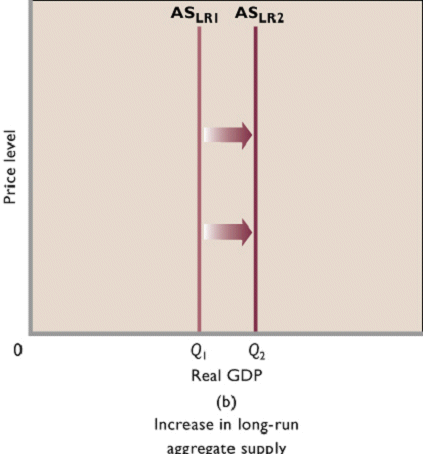
II. Chapter 17: Two (or Three) Definitions
A: From Chapter 8: "Two" definitions of economic growth are given.1. The increase in real GDP, which occurs over a period of time.2. The increase in real GDP per capita, which occurs over time. This definition is superior if comparison of living standards is desired. For example, China's 2001 GDP was $1131 billion compared to Denmark's $166 billion, but per capita GDP's wee $890 and $31,090 respectively.
Growth in real GDP does not guarantee growth in real GDP per capita. If the growth in population exceeds the growth in real GDP, real GDP per capita will fall.
B. But I like my two (or three) definitions better:
1. Increasing our ABILITY to Produce (Ch. 2 Definintion)INCREASING THE POTENTIAL REAL GDPa. "economic growth" on the 5Es chart
b. production possibilities curve
c. AD and AS model: AS (graph)
d. causes:
(1) change in input prices (more resources)
(2) changes in the productivity of resource (better resources, better technology)
(3) legal-institutional environment2. Increasing Real GDP (increasing output, definition often used in the news) "Ch. 17 definition"
ACHIEVING THE POTENTIAL REAL GDPa. achieving "full employment" and "productive efficiency" (5Es)
b. production possibilities curve
c. AD and AS model: AD
3. increasing GDP per capita
C. A new model to illustrate the first definition (INCREASING THE POTENTIAL REAL GDP)
1. First, if there is an increase in AD (from AD1 to AD2)2. then, the price level will increase from P1 to P2
3. a higher price level will cause an increase in the price of resources
4. higher resource prices is a determinant of AS, so AS decreases from AS1 to AS2
5. RESULT: in the long run the level of real domestic output will stay at the full employment level (Qf)
What if there is an initial DECREASE in AD?
1. If there is an decrease in AD (from AD1 to AD2)2. then the price level will decrease from P1 to P2
3. a lower price level will cause an decrease in the price of resources
4. lower resource prices is a determinant of AS, so AS increases from AS1 to AS2
5. RESULT: in the long run the level of real domestic output will stay at the full employment level (Qf)
On this new model in increase in economic growth will be represented as:
NOTE: this is INCREASING THE POTENTIAL GDP
III. FROM THE TEXTBOOK: Ingredients of Growth - Six Main Ingredients of Growth
A. Supply factors: increase the potential GDP (shift the PPC, increase AS)1. AS determinants (Ch. 11)a. lower price of resources
b. increase in productivity
c. lower business taxes and less red tape2. Supply Factors (Ch. 17)
a. Factors (determinants)(1) increase in quality and quantity of natural resources (land)
(2) increase in quality and quantity of human resources human
(3) increase in the supply (or stock) of capital goods
(4) improvements in technologyb. graphs
(1) production possibilities curve
(2) AS graph)B. Demand Factors: achieve the potential GDP (moving to the PPC or increasing AD
1. Aggregate demand must increase for production to expand.C. Efficiency Factors are also related to growth.
2. Full employment of resources and both productive and allocative efficiency are necessary to get the maximum amount of production possible.
IV. US Economic Growth Rates
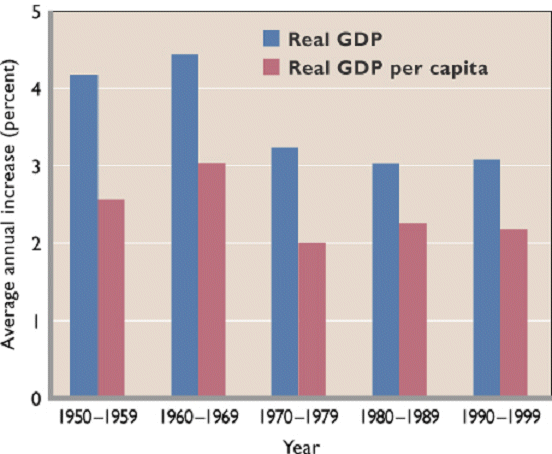
A. Real GDP has increased more than six-fold since 1950, and real per capita GDP has risen by a multiple of three.
B. Rate of growth records shows that real GDP
1. has grown 3.1 percent per year since 1948 and2. real GDP per capita has grown about 2 percent per year.
3. In last four years of the 20th century, U.S. economic growth surged and averaged more than 4 percent per year.
4. But the arithmetic needs to be qualified:
a. Growth doesn’t measure quality improvements.b. Growth doesn’t measure increased leisure time.
c. Growth doesn’t take into account adverse effects on the environment.
d. International comparisons are useful in evaluating U.S. performance. For example, Japan has grown more than twice as fast as the U.S. since 1948, but less in the past decade.
IV. Accounting for Growth
A: Accounting for Growth: ECONOMIC GROWTH IS CAUSED BY:
- more resources
- better resources and technology (more productivity)
B. Accounting for Growth: Table 17.1
C. Accounting for Growth: Inputs (quantity) vs. Productivity (quality)
1. Quantity of Labor
Labor force has grown about 2 million workers per year for past 25 years and accounts for about one-third of total economic growth.2. Technological Advance
a. the most important factor
b. estimated to contribute to about 26 percent of the U.S. growth record since 1929.3. Quantity of Capital
estimated to have contributed 18% to economic growth in U.S. since 1929.a. role of saving
b. Production Possibilities Curve4. Education and Training
estimated to have contributed 11% to economic growth in U.S. since 1929.5. Improved Resource Allocation : Productive Efficiency
contribute to growth and explain about 6% of total.
- discrimination disappears
- labor moves where it is most productive
- tariffs and other trade barriers are lowered.
6. Economies of Scale
contribute to growth and explain about 6% of total.
- the size of markets and firms that serve them have grown.
- role of international trade
7. Other Factors
Other factors influence growth and are more difficult to measure.a. Social-cultural environment and political stability are "growth friendly" in U.S.Respect for material success provides incentive to increase incomes. Market system rewards actions that increase output. Property rights and legal system encourage growth. b. Positive attitudes toward work and flow of energetic immigrants also add to growth.
V. The Productivity Acceleration: A New Economy?
(Figure 17-7)
A. A New Economy? - Improvement in standard of living is linked to labor productivity – output per worker per hour.
B. A New Economy? - The U.S. is experiencing a resurgence of productivity growth based on innovations in computers and communications, coupled with global capitalism. Since 1995 productivity growth has averaged 2.8% annually – up from 1.4% over 1973-95 period. The “Rule of 70” projects real income will double in 23 years rather than 50 years.
C. A New Economy? - Much of the recent improvement in productivity is due to “new economy” factors.
1. Microchips and information technology are the basis for improved productivity. Many new inventions are based on microchip technology.2. New firms and increasing returns characterize the new economy.
Some of today’s most successful firms didn’t exist 25 years ago: Dell, Compaq, Microsoft, Oracle, Cisco Systems, America Online, Yahoo, and Amazon.com are just a few of many.3. Economies of sale and increasing returns in new firms encourage rapid growth
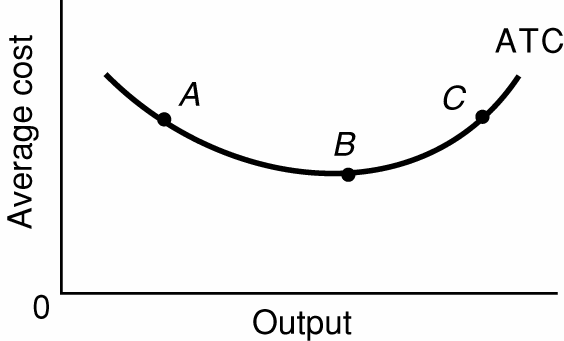
Sources of increasing returns include:a. More specialized inputs.
b. The ability to spread development costs over large output quantities since marginal costs are low.
c. simultaneous consumption by many customers.
d. Network effects make widespread use of information goods more valuable as more people use the products.
e. Learning increases with practice.
4. Global competition encourages innovation and efficiency.
D. A New Economy? - Macroeconomic outcomes of the "new economy" include increases in aggregate supply (shift to right).
(See Figure 17-3.)E. A New Economy? - In the "new economy" faster growth without inflation is possible with higher productivity.
F. A New Economy? - In the "new economy" the natural rate of unemployment seems to be lower (4.0 – 5.0%).
G. A New Economy? - Federal revenues increase with economic growth; a 1995 deficit of $160 billion became a $167 billion surplus in 2000. (figure 12.3)
H. A New Economy? - Skepticism about long-term continued growth remains, and only time will tell.
VI. Is Growth Desirable and Sustainable?
A. An antigrowth view exists.1. Growth causes pollution, global warming, ozone depletion, and other problems.2 . "More" is not always better if it means dead-end jobs, burnout, and alienation from one’s job.
3. High growth creates high stress.
B. Others argue in defense of growth.
1. Growth leads to an improved standard of living.2. Growth helps to reduce poverty in poor countries.
3. Growth has improved working conditions.
4. Growth allows more leisure and less alienation from work.
5. Growth allows more leisure and less alienation from work.
6. Environmental concerns are important, but growth actually has allowed more sensitivity to environmental concerns and the ability to deal with them.
C. Is growth sustainable? Yes, say proponents of growth.
1. Resource prices are not rising.2. Growth today has more to do with expansion and application of knowledge and information, so is limited only by human imagination.
REVIEW
1. State two (three) definitions of economic growth.
2. Suppose an economy's real GDP is $50,000 in year 1 and $55,000 in year 2.
a. What is the growth rate of its GDP?b. Assume that population was 100 in year 1 and 105 in year 2. What is the growth rate in GDP per capita?
3. Explain why even small changes in the rate of economic growth are significant. Use the "rule of 70" to demonstrate the point.
4. Which is more important — increasing inputs of resources or increasing the productivity of those inputs — as the main source of economic growth in the United States? Explain.
5. Summarize the historical growth record of the United States over the past 50 years in terms of real GDP growth and in terms of real GDP per capita growth.
|
ANSWERS: 1. State two (three) definitions of economic growth. Economic growth can first be defined and measured as an increase in real GDP occurring over a period of time. This could be caused by an increase in the potential GDP or simply achieving the potential GDP 2. Suppose an economy's real GDP is $50,000 in year 1 and $55,000 in year 2. a. What is the growth rate of its GDP? 3. Explain why even small changes in the rate of economic growth are significant. Use the "rule of 70" to demonstrate the point. Small changes in the rate of growth can be very meaningful, especially for a country where a fraction of a percent change in the growth rate may mean the difference between starvation and hunger. Over a period of time small changes are cumulative in the same way that compound interest payments are cumulative on a bank account. Using the rule of 70 to estimate the time it takes to double GDP, we can see that a country whose growth rate is 5% takes 14 years to double its GDP, but a country whose growth rate is 3% may take nearly 10 years longer to double its GDP or about 23.3 years. If these countries continued to grow at their respective 5% and 3% rates, in 28 years the first country's GDP would be quadrupled, whereas in the second country, it would take nearly 47 years to quadruple its GDP from the current year. [text: E p. 132; MA p. 132] 4. Which is more important — increasing inputs of resources or increasing the productivity of those inputs — as the main source of economic growth in the United States? Explain. Both resource quantity and resource productivity contribute significantly to increased economic growth in the United States. About a third of the increase in economic growth comes from increases in resource input and about two-thirds from increases in resource productivity. Clearly, it is not the quantity of resources that is most important but the quality of resources and how they are used for production. [text: E p. 132; MA p. 132] 5. Summarize the historical growth record of the United States over the past 50 years in terms of real GDP growth and in terms of real GDP per capita growth. The real GDP has increased about 3.5% per year between 1950 and 2000. Real GDP per capita rose more slowly because population has grown along with GDP. Still the GDP per capita growth has expanded at about 2.3% per year since 1950. [text: E pp. 132-133; MA pp. 132-133] |